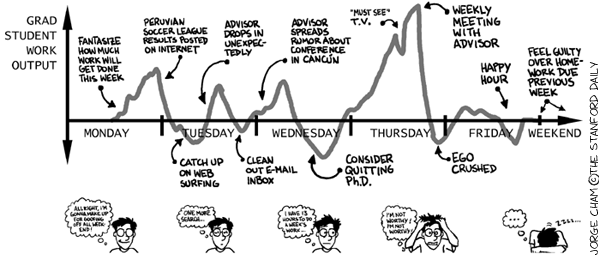
Switching my work flow to Pomodoro for grad studies - part I: motivation
The start of my journey as a PhD student last September was a big step, but also an opportunity to review and improve my working habits. My day time had to be used properly, both for results’ sake and to be able to keep a balanced life.
I had been introduced to the Pomodoro technique at Equisense (thanks Camille!) but remained skeptical as for its potential value within my work flow at the time.
To make it short, the technique consists in the following steps:
- Decide what task should be worked on.
- Allocate a given time to work (around 25 minutes)
- Set a timer and get to work
- When the time is up, make a short pause (~5 minutes), then repeat
- After 4 work sprints, take a longer break (~15-30 minutes)
What was wrong with that?
The development, test and operation phases were generally self-determining and lead to sprints from 20 to 120 minutes (that length isn’t surprising for some tasks and when highly focused). These were also often interrupted by team interactions (required concertation with members of the tech and product team, backend-specific collaborative problem-solving, …). The main point was that there are enough spontaneous interruptions of the work flow, no need to introduce an additional artificial one. As I look back, I still think this was a valid reason not to use this technique.
What has changed?
Time management as a grad student has to be un- and re-learned: rules are different, criteria for success change and so on.

Time management seen by PhD comics [2]
Problem structure: programming at a startup vs. applied math
In my case, the major part of the workload switched from an implementation-heavy to a modeling-heavy context. As such, the work phases tend to be longer and with an heavier cognitive load. I am not saying that programming is easier, but I’m pretty sure mathematics almost always requires to keep more information in mind while working on a problem. Another opinion is that the part of instinct to find a path towards a solution is higher in mathematics.
While programming, there are some key techniques that reduce the number of possible sources to a problem:
- Getting information on the state of the program at a given point (logging, debugging, printing to
stdout) - Testing the behavior of an isolated piece of the program with given input
These techniques also work for scientific computing of course, but are harder to apply to both modeling and symbolic calculus, the different pieces of the problem have to be combined to find special structures which allow for a resolution. More solutions also tend to come while NOT looking at mathematical problem than for programming problems, where solutions come either in front of the code or when voluntarily thinking of the problem.
Team-dependent work vs. figure it out for yourself
Most startups obviously value team work, it is one of the group skills that differentiate companies building great things from the ones stuck in an eternal early stage. This was even more true at Equisense where collaboration and product development were both very synchronous by modern standards. It had cons but ease two things:
- Speed of product development. Lots of team under-estimate post-development coordination, the last meters of the sprint to have a feature ready
- Programming by constraints. Because of fast interactions between the people responsible for the different components, constraints from each one is quickly communicated and the modeling process is defined accounting for them right away.
Now in research, especially in applied mathematics, the work is mostly independent, synchronization happens when working on a joined project for instance. This means that all the interruptions that were happening throughout the day are now gone! Nothing would stop you from working day and night without a break.
Conclusion
Two key results of this change of work style are:
- Work sprints are not naturally bound anymore, obviously with decreasing efficiency
- Few to no interactions interrupt the sprints either
My conclusion was the necessity of a time management technique and associated tools, with a low cognitive overhead and bringing as little distraction as possible.
From these criteria, I rejected a mobile app, smartphones are great to bring different sources of information and communication channels together, not for remaining focused for hours, mobile apps are designed to catch and retain attention, that’s simply part of their business model. I also rejected web-based solutions for the constraint of firing up a browser, amongst the heaviest pieces of software on our modern desktops, just to start a working session.
So desktop GUI or CLI it is. Even though there is the gnomepomodoro project, it did not seem compatible with all Linux desktops. At that point, I realized the amount of work to build a Pomodoro was low, the requirements and constraints well known, I throw ideas together and start coding.
I’ll explain the initial development and iterations of the app in Go in a second article, if you liked this one, let me know!